Chapter 14: Sources of finance
Chapter learning objectives
Upon completion of this chapter you will be able to:
- discuss the criteria which may be used by companies to choose between sources of finance
- explain the relationship between risk and return.
- discuss increasing the efficiency of working capital management as a source of finance
- discuss the advantages and disadvantages of lease finance as a source of short-term finance
- suggest appropriate sources of short-term finance for a business in a scenario question
- define and distinguish between equity finance and other types of share capital
- discuss the advantages and disadvantages of using retained earnings as a source of finance
- explain the benefits of a placing for an unlisted company
- describe the features and methods of a stock exchange listing including a placing and a public offer
- describe a rights issue
- calculate the theoretical ex-rights price (TERP) of a share
- demonstrate the impact of a rights issue on the wealth of a shareholder
- discuss the advantages and disadvantages of equity finance as a source of long-term finance
- identify and suggest appropriate methods of raising equity finance for a business in a scenario question
- explain the main sources of long-term debt finance available to a business
- discuss the advantages and disadvantages of debt finance as a source of long-term finance
- discuss the advantages and disadvantages of lease finance as a source of long-term finance
- discuss the advantages and disadvantages of venture capital as a source of long-term finance
- suggest appropriate sources of long-term finance for a business in a scenario question
- describe the financing needs of small businesses
- describe the nature of the financing problem for small businesses in terms of the funding gap, the maturity gap and inadequate security
- explain measures that may be taken to ease the financing problems of small and medium enterprises (SMEs), including the responses of government departments and financial institutions
- identify appropriate sources of finance for an SME in a scenario question and evaluate the financial impact of the different sources of finance on the business
- explain the major difference between Islamic finance and other forms of business finance
- explain the concept of interest (riba) and how returns are made by Islamic financial securities
- identify and briefly discuss a range of short and long term Islamic financial instruments available to businesses
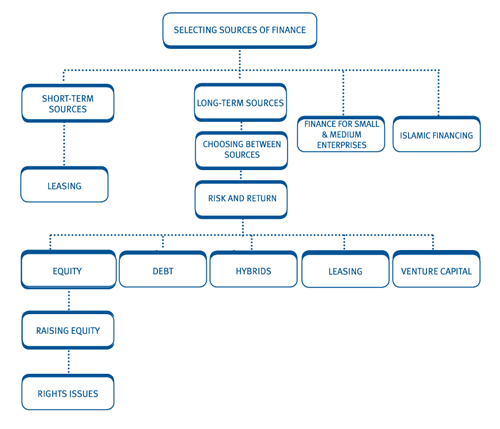
1 Selection of appropriate sources of finance
The need for finance
Firms need funds to:
- provide working capital
- invest in non-current assets.
The main source of funds available is retained earnings, but these are unlikely to be sufficient to finance all business needs.
Criteria for choosing between sources of finance
A firm must consider the following factors:

 The above provides a useful checklist of headings for an examinationsquestion that asks you to consider different types of finance.
The above provides a useful checklist of headings for an examinationsquestion that asks you to consider different types of finance.

 Criteria
Criteria
A vast range of funding alternatives is open to companies and newdevelopments occur every day. Before examining the various sources offinance available it is useful to consider some of the criteria whichmay be used to choose between them.
Cost
The higher the cost of funding, the lower the firm's profit. Debtfinance tends to be cheaper than equity. This is because providers ofdebt take less risk than providers of equity and therefore earn lessreturn. Interest on debt finance is also normally corporation taxdeductible, while returns on equity are not.
Duration
Finance can be arranged for various time periods. Normally, but notinvariably, long-term finance is more expensive than short-termfinance. This is because lenders normally perceive the risks as beinghigher on long-term advances. Long-term finance does, however, carry theadvantage of security, whereas sources of short-term finance can oftenbe withdrawn at short notice. You should remember 'The MatchingPrinciple' that says:
'Long-term assets should be financed by long-term funds and short-term assets (to some extent) by short-term funds'.
We would generally expect to see working capital financed partly byshort-term facilities such as overdraft, whilst fixed assets should befunded by long-term funds. This principle is commonly broken to gainaccess to cheap short-term funds but the risks involved should beappreciated.
Term structure of interest rates
The term structure of interest rates describes the relationshipbetween interest rates charged for loans of differing maturities.
While short-term funds are usually cheaper than long-term funds,this situation is sometimes reversed and interest rates should becarefully checked.
Imagine the situation where the money markets expected interestrates to fall in the long-term but remain high in the short-term. Inthis situation borrowing short-term could prove quite expensive.
Gearing
Gearing is the ratio of debt to equity finance. Gearing will beinvestigated in depth later, but for now we should appreciate thatalthough high gearing involves the use of cheap debt finance, it doesbring with it the risk of having to meet regular repayments of interestand principal on the loans. If these are not met, the company could endup in liquidation.
On the other hand, too little debt could result in earningsdilution. For example the issue of a large amount of equity to fund anew project could result in a decrease in earnings per share (EPS),despite an increase in total earnings.
Accessibility
Not all companies have access to all sources of finance. Smallcompanies traditionally have problems in raising equity and long-termdebt finance. These problems are investigated later (chapter 17) butremember that many firms do not have an unlimited choice of fundingarrangements.
A quoted company is one whose shares are dealt in on a recognisedstock market, so shares in such a company represent a highly liquidasset. This, in turn, makes it much easier to attract new investors tobuy new shares issued by the company because these investors know thatthey can always sell their shares if they wish to realise theirinvestment.
Investment in shares of unquoted companies represents theacquisition of a highly illiquid investment. For this reason it is muchmore difficult for such a company to raise finance by new share issues.

2 The relationship between risk and return
Investment risk arises because returns are variable and uncertain.An increase in risk generally requires an increase in expected returns.
For example compare:
Building society investment versus Investment in equities
Investment in food retailing versus Investment in computer electronics
In each case an investor would demand higher returns from the second investment because of the higher risk.
 Eachtime an investor demands a higher return on the finance they haveprovided, this is reflected in a higher cost of that finance to thecompany.
Eachtime an investor demands a higher return on the finance they haveprovided, this is reflected in a higher cost of that finance to thecompany.
This is a fundamental principle in the F9 syllabus.
3 Short-term sources of finance
As discussed earlier, working capital is usually funded using short-term sources of finance.
Sources of short-term finance include:
- bank overdrafts
- bank loans
- better management of working capital
- squeezing trade credit
- leasing
- sale and leaseback

 Short term finance
Short term finance
With the exception of leasing and sale and leaseback, all othersources of finance have already been covered in the earlier chapters onworking capital management.
Leasing as a source of short-term finance
Growing in popularity as a source of finance, a lease is:
- a contract between a lessor and a lessee for the hire of a particular asset
- lessor retains ownership of the asset
- lessor conveys the right to the use of the asset to the lessee for an agreed period
- in return lessor receives specified rentals.
Leasing is a means of financing the use of capital equipment, theunderlying principle being that use is more important than ownership. Itis a medium-term financial arrangement, usually from one to ten years.
There are two main types of lease agreement:
- operating leases – short-term
- finance leases – long-term.
This section will consider operating leases. Finance leases areconsidered later in the chapter as a source of long-term finance.
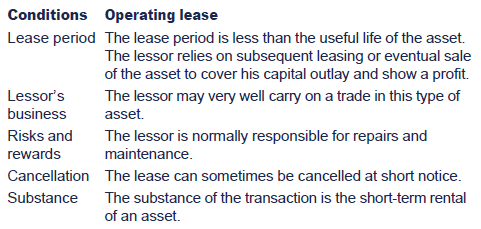
Sale and leaseback
A company that owns its own premises can obtain finance by sellingthe property for cash and renting it back off the acquiror, which wouldtypically be an insurance company or a pension fund.
Although this can provide an immediate source of cash, often morethan could be obtained from a mortgage, there are a number ofdisadvantages including:
- The company loses ownership of the property and will therefore miss out on any appreciation in the property's future value.
- The company will have to sign a rental agreement, usually for at least 50 years, thereby committing the company to occupying the property for many years ahead. This can be restricting.
- The future borrowing capacity of the company will reduce as property is a common asset used to provide security for debt finance.
- Any rent will be subject to regular reviews and will most likely increase over time.

4 Long-term finance – equity
Types of share capital
 Equity shareholders are the owners of the business and exercise ultimate control, through their voting rights.
Equity shareholders are the owners of the business and exercise ultimate control, through their voting rights.
The term equity relates to ordinary shares only.
 Equity finance is the investment in a company by the ordinaryshareholders, represented by the issued ordinary share capital plusreserves.
Equity finance is the investment in a company by the ordinaryshareholders, represented by the issued ordinary share capital plusreserves.
There are other types of share capital relating to various types ofpreference share. These are not considered part of equity, as theircharacteristics bear more resemblance to debt finance.

 Types of share capital
Types of share capital
The main types of share capital are summarised in the table below:

Ensure you are familiar with the key features of each type of share.

5 Raising equity
There are three main sources of equity finance:
- internally-generated funds – retained earnings
- rights issues
- new external share issues – placings, offers for sale, etc.
Internally-generated funds
Internally-generated funds are earnings retained in the business(i.e. undistributed profits attributable to ordinary shareholders).
For an established company, internally-generated funds canrepresent the single most important source of finance, for both shortand long-term purposes.
Such finance is cheap and quick to raise, requiring no transaction costs, professional assistance or time delay.
Retained earnings are also a continual source of new funds,provided that the company is profitable and profits are not all paid outas dividends.
Of course, for major investment projects, a greater amount ofequity finance may be required than that available from internalsources.
6 Rights issues
 A rights issue is an offer to existing shareholders to subscribe fornew shares, at a discount to the current market value, in proportion totheir existing holdings.
A rights issue is an offer to existing shareholders to subscribe fornew shares, at a discount to the current market value, in proportion totheir existing holdings.
This right of pre-emption:
- enables them to retain their existing share of voting rights
- can be waived with the agreement of shareholders.
Shareholders not wishing to take up their rights can sell them on the stock market.
Advantages:
- it is cheaper than a public share issue
- it is made at the discretion of the directors, without consent of the shareholders or the Stock Exchange.
- it rarely fails.
TERP
The new share price after the issue is known as the theoretical ex-rights price and is calculated by finding the weighted average of the old price and the rights price, weighted by the number of shares.
The formula is:


 Test your understanding 1 – TERP
Test your understanding 1 – TERP
Babbel Co, which has an issued capital of 2 million shares, having acurrent market value of $2.70 each, makes a rights issue of one newshare for every two existing shares at a price of $2.10.
Required:
Calculate the TERP.


 Test your understanding 2 – TERP
Test your understanding 2 – TERP
ABC Co announces a 2 for 5 rights issue at $2 per share. There arecurrently 10 million shares in issue, and the current market price ofthe shares is $2.70.
Required:
Calculate the TERP.

The value of a right
To make the offer relatively attractive to shareholders, new sharesare generally issued at a discount on the current market price.
 Value of a right = theoretical ex rights price – issue (subscription) price
Value of a right = theoretical ex rights price – issue (subscription) price
Since rights have a value, they can be sold on the stock market in the period between:
- the rights issue being announced and the rights to existing shareholders being issued, and
- the new issue actually taking place.

 Test your understanding 3 – The value of a right
Test your understanding 3 – The value of a right
What is the value of the right in Babbel Co?


 Test your understanding 4 – The value of a right
Test your understanding 4 – The value of a right
What is the value of the right in ABC Co?

Shareholders' options
The shareholder's options with a rights issue are to:
(1)take up his rights by buying the specified proportion at the price offered
(2)renounce his rights and sell them in the market
(3)renounce part of his rights and take up the remainder
(4)do nothing.

 Test your understanding 5 – Shareholders' options
Test your understanding 5 – Shareholders' options
Using the information in test your understanding 1, a shareholder Bhad 1,000 shares in Babbel Co before the rights offer. Calculate theeffect on the net wealth of B of each of the following options:
(1)Take up the shares.
(2)Sell the rights.
(3)Do nothing.
The facts were:

Note:
Cum rights price = market value of the share before the rights issue.
Buyers of shares quoted cum rights are entitled to forthcoming rights.


 Additional question - Shareholders' options
Additional question - Shareholders' options
Alpha Co has issued share capital of 100 million shares with acurrent market value of $0.85 each. It announces a 1 for 2 rights issueat a price of 40c per share. It therefore plans to raise $20 million innew funds by issuing 50 million new shares.
Calculate the ex-rights price and for a shareholder, B, holding 1,000 shares in Alpha, consider his wealth if he:
(1)takes up his rights
(2)sells his rights
(3)buys 200 shares and sells the rights to a further 300
(4)takes no action.
The answer to this question can be found after the chapter summary diagram at the end of this chapter.


 New share issues
New share issues
There are several methods of issuing new shares, depending on the circumstances of the company:
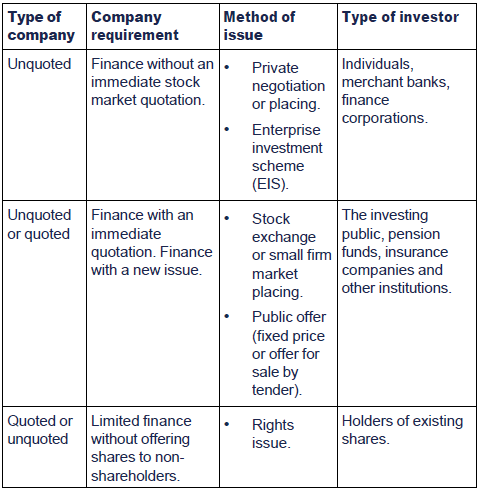
Placing
A placing may be used for smaller issues of shares (up to $15million in value). The bank advising the company selects institutionalinvestors to whom the shares are 'placed' or sold. If the general publicwish to acquire shares, they must buy them from the institutions.
Unquoted companies may find it difficult to raise finance because:
- shares are not easily realisable
- it is cheaper to invest in large parcels of shares rather than in many companies
- small firms are regarded as more risky.
However, unquoted companies can arrange for a placing ofshares with an institution. However, there must usually be at least aprospect of eventually obtaining a quotation on the stock exchange inorder for the placing to be successful.
Enterprise investment scheme
See section on finance for small and medium enterprises
(a)Public offer
A public offer is an invitation to apply for shares in a companybased upon information contained in a prospectus, either at a fixedprice or by tender.
Fixed price offer
Shares are offered at a fixed price to the general public(including institutions). Details of the offer document are published ina prospectus for the issue. The prospectus contains information aboutthe company's past performance and future prospects, as specified by therules for stock exchange companies. The rule book for UK companieswhose shares are listed on the main London Stock Exchange is the UKListing Rules. These are overseen by the UK Listing Authority, adepartment of the Financial Services Authority (FSA).
Offer for sale by tender
Shares are offered to the general public (including institutions)but no fixed price is specified. Potential investors bid for shares at aprice of their choosing. The 'striking price' at which the shares aresold is determined by the demand for shares.
The price will be either:
(a)the highest price at which the entire issue is sold, all tenders at or above this being allotted in full, or
(b)a price lower than in (a), butwith tenders at or above this lower price receiving only a proportion ofthe shares tendered for, so as to avoid the concentration of ownershipin the hands of a few.


 Becoming quoted
Becoming quoted
A company may wish to become listed on the stock exchange toincrease its pool of potential investors. Only by being listed can acompany offer its shares to the public.
It may start with a quotation on a small firm stock market, such asthe Alternative Investment Market (AIM) in the UK, followed by a fulllisting.
The possible methods of obtaining a stock exchange listing in the UK are:

Introduction
Introduction is a process that allows a company to join a stockexchange without raising capital. A company does not issue any freshshares; it merely introduces its existing shares in the market.
It is used where the public already holds at least 25% of theshares in the company (the minimum requirement for a stock exchangelisting). The shares become listed and members of the public can buyshares from the existing shareholders.


 Institutional advisers on new share issues
Institutional advisers on new share issues
As well as requiring the assistance of accountants in preparing the prospectus, new share issues may require the services of an issuing house. An issuing house is an investment bank specialising in new issue of shares.
Issuing houses
A company wishing to raise capital by offer for sale would firstget in touch with one of the issuing houses which specialise in thiskind of business.
In some cases, the issuing house earns a fee by organising publicissues. In others, it purchases outright a block of shares from acompany and then makes them an 'offer for sale' to the public on termsdesigned to bring in a profit to the issuing house.
There are between 50 and 60 members of the Issuing HouseAssociation, including all the important merchant banks. The fact thatan issue is launched by one of these banks or other houses of highreputation is, in itself, a factor contributing to the chance of successof such a venture.
Investment banks
Investment banks also perform the functions of underwriting, marketing and pricing new issues.
- Underwriting: large share issues are usually underwritten which adds to the cost of raising finance but reduces the risk. An underwriter is someone (usually an investment institution) who is prepared to purchase shares in a share issue that other investors do not buy. For example, suppose that XYZ Co is issuing 50 million new shares at $2.50 each. If the issue is underwritten, the investment bank assisting the company with the issue will find one or more institutions that are prepared to buy up to a given quantity of the shares, if no one else wants them. In return for underwriting a portion of the new issue, an underwriter is paid a commission. If there are just one or two underwriters for an issue, the underwriters might offload some of their risk by getting other institutions to sub-underwrite the issue. Sub-underwriters are also paid a commission.
The effect of underwriting is to ensure that all the shares in anew issue will find a buyer. However, if large quantities of the sharesare left in the hands of the underwriters after the issue, the shareprice is likely to remain depressed until the underwriters have beenable to sell off the shares they do not want in the secondary market.
- Marketing: the marketing and selling of a new issue is a business activity in its own right. The investment bank provides the expertise.
- Pricing: one of the most difficult decisions in making a new issue is that it should be priced correctly. If the price is too low, the issue will be over-subscribed, and existing shareholders will have had their holdings diluted more than is necessary. If the price is too high and the issue fails, the underwriters are left to subscribe to the shares. This will adversely affect the reputation of the issuing house and the company. Correct pricing is important, and the investment bank will be able to offer advice based on experience and expertise. One way round the issue price problem is an issue by tender.

7 Choosing between sources of equity
When choosing between sources of equity finance, account must be taken of factors such as:
(1)the accessibility of the finance
(2)the amount of finance
(3)costs of the issue procedure
(4)pricing of the issue
(5)control
(6)dividend policy – using retained earnings could impact the share price (see chapter on dividend policy).
 Becauseof the relative issue costs and the ease of organisation, the mostimportant source of equity is retained earnings, then rights issues,then new issues.
Becauseof the relative issue costs and the ease of organisation, the mostimportant source of equity is retained earnings, then rights issues,then new issues.

 Choosing between sources of equity
Choosing between sources of equity
Accessibility to finance
The ability of a company to raise equity finance is restricted by its access to the general market for funds. Thus, whilst quoted companies are able to use any of the sources, an unquotedcompany is restricted to rights issues and private placings. Theproblem of equity finance for smaller companies is examined later inthis chapter).
Furthermore, there are statutory restrictions, e.g. those in the UKimposed by the Companies Act 1985. Only public limited companies mayoffer shares to the general public.
Obviously, the need to raise finance could be combined with a flotation(i.e. a private company going public and having its shares quoted on arecognised stock exchange). However, flotations will incur significantcosts.
Amount of finance
The amount of finance that can be raised by a rights issue from an unquotedcompany is limited by the number and resources of the existingshareholders. It is not possible to provide general estimates of theamounts that may be raised as the circumstances vary. For quotedcompanies, where rights may be sold, this is less problematic.
Larger sums can be raised by placings, but ultimately it is the offer of shares to the general public that opens up the full financial resources of the market.
Costs of issue procedures
Use of internally-generated funds is easily the cheapest andsimplest method. For new issues, placings are the most attractive oncost grounds, followed by rights issues, with public offers being by farthe most expensive.
However all new share issues will take management andadministrative time within the company. This will be much greater for anoffer for sale than for the other two alternatives.
Pricing of the issue
One of the most difficult problems in making a new issue to the publicis setting the price correctly. If it is too high, the issue will notbe fully taken up and will be left with the underwriters, and if it isunderpriced some of the benefits of the project for which the finance isbeing raised will accrue to the new shareholders and not to the old.
The same pricing problem exists with a placing as with a newissue. There will be no danger of undersubscription, of course, becausethe placing is agreed before the issue is made. However, the price willhave been negotiated so as to be attractive to the subscribinginstitutions. Almost inevitably, it will be below the issue price thatit would obtain in the market, because of the attractions of lower issuecosts.
A rights issue, on the other hand, completely by-passes theprice problem. Since the shares are offered to existing shareholders, itdoes not matter if the price is well below the traded price. Indeed, itwould be normal for this to be so. Any gain on the new shares would, bythe nature of a rights issue, go to the existing shareholders.
The pricing of new issues is even more complex when the company is unquoted.A company coming to the market for the first time would have noexisting market price to refer to and would have to value the sharesfrom scratch.
Control
There is no change in the shareholders with internally-generatedfunds and rights issues, insofar as they are taken up by existingshareholders. On the other hand, placings and sales to the general public introduce new shareholders.
Which is preferable depends on the objectives of the fund-raisingexercise. If the desire is to retain control for the existingshareholders, then a rights issue is preferable. If diversification ofcontrol is desired, then an issue to the public will be preferred.
There can be no rigid rules concerning the choice of finance. Useof internally–generated funds is the best choice, subject tosufficient availability and dividend policy considerations. Of the newissue options, the order of preference will generally be a rightsissue,placing and offer for sale to the general public. As fundsavailable are consumed, so the next source is utilised.

8 Long-term finance – debt
Long-term debt (bonds), usually in the form of debentures or loannotes, is frequently used as a source of long-term finance as analternative to equity.
 A bond is a written acknowledgement of a debt by a company, normallycontaining provisions as to payment of interest and the terms ofrepayment of principal.
A bond is a written acknowledgement of a debt by a company, normallycontaining provisions as to payment of interest and the terms ofrepayment of principal.
Bonds are also known as debentures, loan notes or loan stock. They:
- may be redeemable or irredeemable.
Irredeemable debt is not repayable at any specified time in thefuture. Instead, interest is payable in perpetuity. As well as somebonds, preference shares are often irredeemable.
If the debt is redeemable the principal will be repayable at a future date.

 Illustration 1 – Long-term finance debt
Illustration 1 – Long-term finance debt
If a company has '5% 2015 loan notes redeemable at par, quoted at $95 ex-int', this description refers to loan notes that:
- pay interest at 5% on nominal value, i.e. $5 per $100 (this is known as the coupon rate)
- are redeemable in the year 2015
- will be repaid at par value, i.e. each $100 nominal value will be repaid at $100
- currently have a market value of $95 per $100, without rights to the current year's interest payment.

 The terms 'loan notes' and 'bonds' are now used generally to mean any kind of long-term marketable debt securities.
The terms 'loan notes' and 'bonds' are now used generally to mean any kind of long-term marketable debt securities.
9 Characteristics of loan notes and other long-term debt
Advantages:
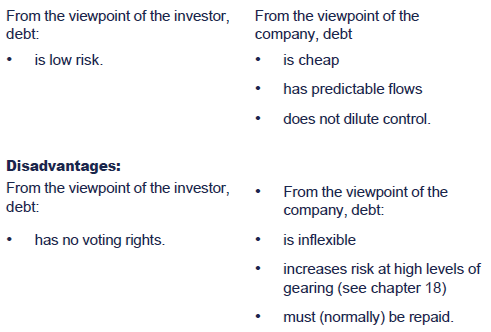
 These are the key points for a discussion about the use of debt in an examination question.
These are the key points for a discussion about the use of debt in an examination question.

 Debt finance
Debt finance
Loan notes from the viewpoint of the investor
Debt is viewed as low risk because:
- it often has a definite maturity and the holder has priority in interest payments and on liquidation
- income is fixed, so the holder receives the same interest whatever the earnings of the company.
Debt holders do not usually have voting rights. Only if interest is not paid will holders take control of the company.
Loan note from the viewpoint of the company
Advantages of debt
- Debt is cheap. Because it is less risky than equity for an investor, loan note holders will accept a lower rate of return than shareholders. Also, debt interest is an allowable expense for tax. So if the cost of borrowing for a company is 6%, say, and the rate of corporation tax is 30%, the company can set the cost of the interest against tax, and the effective 'after-tax' cost of the debt would be just 4.2% (6% × 70%).
- Cost is limited to the stipulated interest payment.
- There is no dilution of control when debt is issued.
Disadvantages of debt
- Interest must be paid whatever the earnings of the company, unlike dividends which can be paid in good years and not in bad. If interest is not paid, the trustees for the loan note holders can call in the receiver.
- Shareholders may be concerned that a geared company cannot pay all its interest and still pay a dividend and will raise the rate of return that they require from the company to compensate for this increase in risk. This may effectively put a limit on the amount of debt that can be raised.
- With fixed maturity dates, provision must be made for the repayment of debt.
- Long-term debt, with its commitment to fixed interest payments, may prove a burden especially if the general level of interest rates falls.
Different types of bonds
There are many different types of bonds available. However, a couple of common types that you should be aware of are:
Deep discount bonds
These are loans notes issued at a price that is a large discount tothe nominal value of the notes, and which will be redeemable at par (orabove par) when they eventually mature.
The low initial price paid by the investor is balanced against alower rate of return (coupon rate) offered on the bond. Much of thereturn gained by the investor comes from the capital gain when the bondis redeemed.
Zero coupon bonds
These are bonds that are issued at a discount to their redemption value but no interest is paid on them.

Hybrids – convertibles
Some types of finance have elements of both debt and equity, e.g.:
 Convertibles give the holder the right to convert to other securities, normally ordinary shares at either a:
Convertibles give the holder the right to convert to other securities, normally ordinary shares at either a:
- predetermined price
- e.g. notes may be converted into shares at a value of 400c per share
- predetermined ratio
- e.g. $100 of stock may be converted into 25 ordinary shares.
 Conversion premium occurs if:
Conversion premium occurs if:
Market value convertible stock > Market price of shares the stock is to be converted into.
Stock trading at $102, to be converted into 10 shares currently trading at $9 each, has a conversion premium of:
102 – (10 × 9) = $12 or $1.20 per share.
 The floor value of a convertible loan note is the minimum market priceof the note. Since it attaches no value to the conversion it can becalculated as the present value of the future interest payments plus thepresent value of the cash redemption value (i.e. the value a straightdebenture would have with no conversion rights).
The floor value of a convertible loan note is the minimum market priceof the note. Since it attaches no value to the conversion it can becalculated as the present value of the future interest payments plus thepresent value of the cash redemption value (i.e. the value a straightdebenture would have with no conversion rights).
Hybrids – loan notes with warrants
 Warrants give the holder the right to subscribe at a fixed future datefor a certain number of ordinary shares at a predetermined price.
Warrants give the holder the right to subscribe at a fixed future datefor a certain number of ordinary shares at a predetermined price.
NB If warrants are issued with loan notes, the loan notes are not converted into equity. Instead bond holders:
- make a cash payment for the shares
- retain the loan notes until redemption.
Often used as sweeteners on debt issues:
- interest rate on the loan is low and loan may be unsecured
- right to buy equity set at an attractive price.
- bond holders can sell the warrants after buying the loan notes, thereby decreasing the cost of buying the loan notes
Attractions of convertibles and warrants
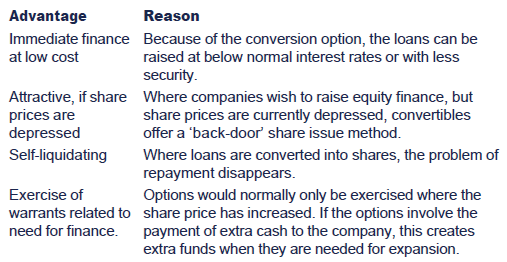
10 Long-term finance – leasing
 The key difference between an operating lease (short-term) and afinance lease (medium to long-term) is that the former equates torenting an asset whereas the latter equates to borrowing money in orderto purchase the asset.
The key difference between an operating lease (short-term) and afinance lease (medium to long-term) is that the former equates torenting an asset whereas the latter equates to borrowing money in orderto purchase the asset.
Long-term lease arrangements are likely to be a finance lease:
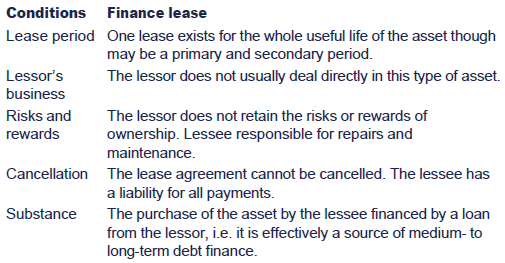
Usually the lease period is divided into two:
The length of the primary period will vary from asset to asset depending on the total expected economic life.
The decision whether to lease or buy is both a practical andfinancial one. The financial choice was discussed in the chapter onasset investment decisions.
11 Venture capital
 Venture capital is the provision of risk bearing capital, usually inthe form of a participation in equity, to companies with high growthpotential.
Venture capital is the provision of risk bearing capital, usually inthe form of a participation in equity, to companies with high growthpotential.
Venture capitalists provide start-up and late stage growth finance, usually for smaller firms.
Venture capitalists will assess an investment prospect on the basis of its:
- financial outlook
- management credibility
- depth of market research
- technical abilities
- degree of influence offered:
- controlling stake?
- board seat?
- exit route.
12 Finance for small and medium enterprises
Small and medium-sized entities (SMEs) tend to be unquoted withownership of the business usually being restricted to a small number ofindividuals. Often the financing needs are beyond the levels of initialseed capital invested by the owner when the business is formed. Capitalwill be required to invest in non-current assets as well as financingthe working capital requirements of the business.
SMEs can often face difficulties when raising finance sinceinvesting in an SME is inherently more risky than investing in a largercompany due to:
- the lack of business history or proven track record
- the lower level of public scrutiny over accounts and records.
Despite accounting for a significant proportion of economicactivity around the world, many SMEs will fail within their first twoyears of trading, often due to an inability to secure sufficientfinance.
The funding gap
As smaller companies tend to be unquoted, it is more difficult forequity investors to liquidate their investment. Typically thereforesmall firms rely on finance from retentions, rights issues and bankborrowings.
However, Initial ('seed') capital is often from family and friends, seriously limiting the scope for further rights issues.
Bank borrowing doesn't always provide a solution either. To controltheir exposure, banks will often use credit scoring systems,effectively creating competition amongst SMEs for the available funds.Additional information in the form of business plans will have to besubmitted and lenders will very often require additional security to beprovided (which the owners may be unwilling or unable to give). Lenderswill also want to monitor their investment more closely.
As a result, a funding gap often arises when they want to expandbeyond these means of finance but are not yet ready for a listing on theStock Exchange or Alternative Investment Market (AIM).
This gap may be bridged with in a number of ways:
- Financial investors including:
- Business angels
- Venture capitalists
- Various government solutions including:
- increasing the marketability of shares
- provision of tax incentives
- other specific forms of assistance

 Financial investors
Financial investors
Small firms are often considered to be more risky. This is a particular issue for newer businesses which may:
- lack proper financial control systems
- have inexperienced management teams
- not have an established track record
- lack sufficient good quality assets to offer as security (it is common for the owners of the business to be asked for personal guarantees).
Although banks remain reluctant to invest heavily in SMEs because of:
- the lack of security
- their risk-averse approach
Investment has become more readily available from:
- venture capitalists – who provide risk-bearing capital to companies with high growth potential
- business angels – wealthy individuals investing in start-up, early stage or expanding firms, at lower levels than a venture capitalist (typically between £10,000 and £250,000 per deal).
Banks
Traditionally, small businesses have borrowed by means of loans andoverdrafts from clearing banks. The main problems have always been the security required by the bank for granting the loan, and the risk averse attitude of bankswhen faced with a decision relating to a new and untested project. Inthe UK, the requirement for a personal guarantee from the proprietor tocover the loan or overdraft advance has inhibited the expansion of manysmall businesses and contributed towards the problem of British ideasbeing developed abroad.
Whilst the UK government has attempted to make debt investment insmall businesses more attractive by the introduction of its LoanGuarantee Scheme, this has not proved very successful due to itsrelatively high interest rate.
Venture capital funds
The combination of increasing the prospective marketability of SMEshares and tax relief schemes has led to the proliferation of venturecapital funds, which provide equity capital for small and growingbusinesses.
One of the original, and still one of the best known, venturecapital institutions in the UK is that forming part of the 3i Group. Ittakes a continuing interest in its client enterprises and does notrequire to withdraw the capital after, say, a five-year period.
However, in recent years, most major providers of business financehave in some way become involved in the provision of venture capital,usually by setting up or participating in specialist 'venture capitalfunds'. The main spur to their growth has come from the incentivesdescribed above.
The result is that there is now no real shortage of venture capitalfor viable projects. The range of possible funds includes those run bymerchant and other banks, pension funds, individuals and localauthorities.
Business angels
Although venture capital companies are the main providers of equityfinance to small businesses, they are highly selective and normally donot invest in amounts under £100,000 in the UK. An alternative sourceof smaller amounts of equity capital are private individuals, sometimesknown as business angels, who normally have a business background.
Business angels are willing to make investments in small businessesin return for an equity stake. They can also offer the businesses thebenefits of their own management expertise. A number of business angelnetworks operate in the UK to match businesses seeking equity financewith potential investors.


 Additional question - Finance for SMEs
Additional question - Finance for SMEs
Toogood Gardens is a private company that owns and operates a smallchain of florists and garden centres in the south west. They haveexpanded rapidly since they opened 3 years ago, financing the expansionmainly through retained profits.
The directors are now considering a major expansion opportunity as asimilar chain in a neighbouring area has become available for sale.
Advise the directors about the best way to raise funds to buy the chain, if a share-for-share deal is not available.
The answer to this question can be found after the chapter summary diagram at the end of this chapter.


 Government solutions
Government solutions
Governments have adopted a two-pronged response to increasing the attractiveness of SMEs:
- increasing marketability of shares
- tax incentives for investors.
In addition they have provided specific assistance in a range of areas (see below).
Making shares marketable
A number of SMEs that have good business ideas and growth potentialdo not fulfil the profitability/track record requirements to obtain afull stock exchange listing.
The development of small firm markets, such as the AIM in the UKand the Growth Enterprise Market (GEM) in Hong Kong SAR, is designed tobridge this gap and provide both an exit ground and a venue for furtherfund-raising for investments.
In addition companies in the UK are now able to purchase their own shares, so a small investor can be bought out as needed.
Tax incentives
The following are the responses of the UK government which illustrate the types of incentives available:
The Enterprise Investment Scheme (EIS)
The Wilson Committee's recommendations led to the development ofthe current EIS which offers tax relief on investments in new ordinaryshares in qualifying unlisted trading companies, including those tradedon the AIM. There is a limit on the amount an individual may invest(currently up to £400,000 each tax year) and the investment qualifiesfor 20% income tax relief.
Any gain on disposing of EIS shares after 3 years is exempt fromcapital gains tax (CGT). Income tax or CGT relief is available onlosses.
The scheme applies to any company carrying out a qualifying tradeor business activity wholly or mainly in the UK, provided that thecompany's gross assets do not exceed £7 million immediately before theshares are issued. It enables companies to raise up to £1m a year.Participating investors may become paid directors of the company and incertain circumstances still qualify for the relief.
Venture Capital Trusts (VCTs)
VCTs are companies listed on the London Stock Exchange and are similar to investment trusts.
At least 70% of the underlying investments must be held in a spreadof small unquoted trading companies within three years of the date oflaunch.
The aim is to encourage individuals to invest indirectly in arange of small higher-risk trading companies whose shares and securitiesare not listed on a recognised stock exchange. By investing through aVCT, the investment risk is spread over a number of companies.
Income tax relief is available at 30% on new subscriptions by individuals for ordinary shares in VCTs, to a maximum of£200,000 pa. In addition, subject to certain conditions, CGT relief is available on disposal of the shares.
Share incentive schemes
In the UK, there are schemes designed to encourage employees tohold shares in companies by which they are employed. All such schemesrequire HM Revenue and Customs (HMRC) approval.
Specific forms of assistance
This may take the form of:
- business links – a largely government-funded service that provides information, advice and support to those wishing to start, maintain and grow a business
- financial assistance:
- loan guarantees
- grants
- loans.
Whilst you are not expected to have a detailed knowledge ofparticular government schemes, you should have a general awareness ofthe type of assistance offered.
Here we shall concentrate on the financial aspects of government assistance:
Small Firms Loan Guarantee Scheme (SFLGS)
This provides a government guarantee for loans by approved lenders.Loans are made to firms or individuals unable to obtain conventionalfinance because of a lack of track record or security. The guaranteegenerally covers 70% of the outstanding loan. This rises to 85% forestablished businesses trading for two years or more. Loans can be foramounts between £5,000 and £100,000 (£250,000 for establishedbusinesses) and over a period of two to ten years.
NB. Not all businesses are eligible for a loan and there are some restrictions on their use.
Regional Selective Assistance (RSA)
This is a discretionary scheme available in those parts of the UKdesignated as Assisted Areas. It takes the form of grants to encouragefirms to locate or expand in these areas. Projects must either createnew employment or safeguard existing jobs.
In England, for example, RSA is available for projects involving capital expenditure of at least £500,000.
Enterprise grants
This is a selective scheme for firms employing fewer than 250people. It is available for high quality projects in designated areas.Businesses may only receive one such grant.
Regional innovation grants
This is available in certain areas of the UK to encourage thedevelopment of new products and processes. It is available toindividuals or businesses employing no more than 50 people. The schemeprovides a fixed grant of up to 50% of eligible costs up to a maximum of£25,000.
Small firms training loans
These are available through the Department for Education andEmployment and eight major banks in the UK. The scheme helps businesseswith up to 50 employees to pay for vocational education or training, byoffering loans on deferred repayment terms:
- firms can borrow between £500 and £125,000 for between 1 and 7 years to cover education and training costs and, with restrictions, costs of consultancy advice on training matters
- the interest on the loan can be fixed or variable, and is paid by the Department for the first 6 to 12 months
- any education or training is eligible provided the firm can show that it will help them achieve their business objectives.
European Investment Bank (EIB) and European Investment Fund (EIF) schemes
The EIB provides loans to banks and leasing companies to helpprovide finance to small and medium-sized companies. The operators ofEIB-supported schemes include finance organisations such as BarclaysMercantile, Lombard Business Finance and Forward Trust.
The EIF provides loan guarantees in conjunction with some financeorganisations' own environmental loan facilities. These facilities aredesigned to assist business to finance investments that produce aquantifiable environmental benefit (energy usage, raw material usage,etc.).

13 Islamic finance
Islamic finance has the same purpose as other forms of businessfinance except that it operates in accordance with the principles ofIslamic law (Sharia).
The basic principles covered by Islamic finance include:
- Sharing of profits and losses.
- No interest (riba) allowed.
- Finance is restricted to Islamically accepted transactions. i.e. No investment in alcohol, gambling etc.
Therefore, ethical and moral investing is encouraged.
Instead of interest being charged, returns are earned by channelingfunds into an underlying investment activity, which will earn profit.The investor is rewarded by a share in that profit, after a managementfee is deducted by the bank.
The main sources of finance within the Islamic banking model include:
- Murabaha (trade credit)
- Ijara (lease finance)
- Sukuk (debt finance)
- Mudaraba (equity finance)
- Musharaka (venture capital)

 Islamic financing
Islamic financing
The Islamic economic model has developed over time based on therulings of Sharia on commercial and financial transactions. The Islamicfinance framework seen today is based on the principles developed withinthis model. These include:
- An emphasis on fairness such that all parties involved in a transaction can make informed decisions without being misled or cheated. Equally reward should be based on effort rather than for simple ownership of capital,
- The encouragement and promotion of the rights of individuals to pursue personal economic wellbeing, but with a clear distinction between what commercial activities are allowed and what are forbidden (for example, transactions involving alcohol, pork related products, armaments, gambling and other socially detrimental activities). Speculation is also prohibited (so instruments such as options and futures are not allowed). Ethical and moral investing is encouraged,
- The strict prohibition of interest (riba). Instead interest is replaced with cash flows from productive sources, such as returns from wealth generating investment activities.
How returns are earned
Riba is defined as the excess paid by the borrower over theoriginal capital borrowed i.e the equivalent to interest on a loan. Itsliteral translation is 'excess'.
Within the conventional banking system, a bank get access to fundsby offering interest to depositers. It will then apply those funds bylending money, on which it charges interest. The bank makes a profit bycharging more interest on the money it lends than it pay to itsdepositers. This process is outlawed under Islamic finance.
In an Islamic bank, the money provided by depositers is not lent,but is instead channelled into an underlying investment activity, whichwill earn profit. The depositor is rewarded by a share in that profit,after a management fee is deducted by the bank.
For example, in an Islamic mortgage transaction, instead of loaningthe buyer money to purchase the item, a bank might buy the item itselffrom the seller, and re-sell it to the buyer at a profit, while allowingthe buyer to pay the bank in installments. However, the bank's profitcannot be made explicit and therefore there are no additional penaltiesfor late payment.
In effect, the interest is replaced with cash flows from productivesources, such as returns from wealth generating investment activitiesand operations. These include profits from trading in real assets andcash flows from the transfer of the right to use an asset (for example,rent).
Islamic sources of finance
In Islamic Banking there are broadly 2 categories of financing techniques:
- "Fixed Income" modes of finance – murabaha, ijara, sukuk
- Equity modes of finance – mudaraba, musharaka
Each of these is discussed in more detail below:
Murabaha
Murabaha is a form of trade credit or loan. The key distinctionbetween a murabaha and a loan is that with a murabaha, the bank willtake actual constructive or physical ownership of the asset. The assetis then sold onto the 'borrower' or 'buyer' for a profit but they areallowed to pay the bank over a set number of installments.
The period of the repayments could be extended but no penalties oradditional mark up may be added by the bank. Early payment discounts arenot welcomed (and will not form part of the contract) although thefinancier may choose (not contract) to give discounts.
Ijara
Ijara is the equivalent of lease finance; it is defined as when theuse of the underlying asset or service is transferred forconsideration. Under this concept, the Bank makes available to thecustomer the use of assets or equipment such as plant, officeautomation, or motor vehicles for a fixed period and price. Some of thespecifications of an Ijara contact include:
- The use of the leased asset must be specified in the contract.
- The lessor (the bank) is responsible for the major maintenance of the underlying assets (ownership costs)
- The lesses is held for maintaining the asset in good shape
An Islamic lease is more like an operating lease but the redemptionfeatures may be structured to make it similar to a finance lease.
Sukuk
Within other forms of business finance, a company can issuetradable financial instruments to borrow money. Key feature of thesedebt instruments are they:
- Don't give voting rights in the company,
- Give right to profits before distribution of profits to shareholders
- May include securities and guarantees over assets
- Include interest based elements
All of the above are prohibited under Islamic law. Instead, Islamicbonds (or sukuk) are linked to an underlying asset, such that asukukholder is a partial owner in the underlying assets and profit islinked to the performance of the underlying asset. So for example asukukholder will participate in the ownership of the company issuing thesukuk and has a right to profits (but will equally bear their share ofany losses).
Mudaraba
Mudaraba is a special kind of partnership where one partner givesmoney to another for investing it in a commercial enterprise. Theinvestment comes from the first partner (who is called 'rab ul mal'),while the management and work is an exclusive responsibility of theother (who is called 'mudarib').
The Mudaraba (profit sharing) is a contract, with one partyproviding 100% of the capital and the other party providing itsspecialist knowledge to invest the capital and manage the investmentproject. Profits generated are shared between the parties according to apre-agreed ratio. In a Mudaraba only the lender of the money has totake losses.
This arrangement is therefore most closely aligned with equity finance.
Musharaka
Musharaka is a relationship between two or more parties, whocontribute capital to a business, and divide the net profit and loss prorata. It is most closely aligned with the concept of venture capital.All providers of capital are entitled to participate in management, butare not required to do so. The profit is distributed among the partnersin pre-agreed ratios, while the loss is borne by each partner strictlyin proportion to their respective capital contributions.

Chapter summary

 Answer to additional question - Shareholders' options
Answer to additional question - Shareholders' options
The TERP is $0.80, calculated as follows:

The value of each right is $0.30 per new share issued
($0.70 – $0.40 = $0.30)
Shareholder's choices:
(1)Take up his rights
Buy the new shares to which he is entitled. He can buy 500 newshares at $0.40, which will mean investing an additional $200 in thecompany.

Investor B will now have an investment of 1,500 shares that in theory will be worth $1,050 ($0.70 per share).
The value of the total investment has gone up by $200, but this isthe amount of the additional investment he has made to acquire the newshares, so his wealth is unchanged.
(2)Sell his rights
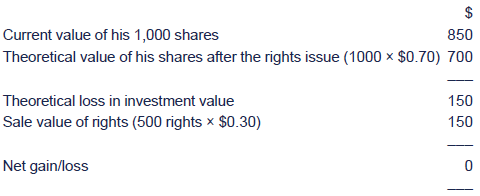
By selling his rights, investor B receives $150, but the value ofhis investment is likely to fall by $150, leaving him no better and noworse off overall.
(3)Buys 200 shares and sells 300 rights
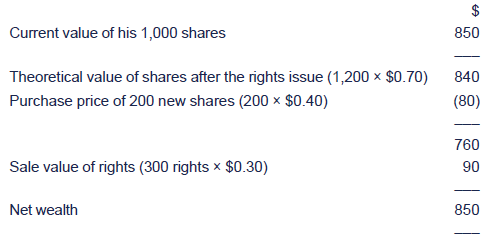
Again his overall wealth is unchanged.
(4)Take no action
If investor B takes no action, the value of his shares is likely tofall from $850 before the rights issue to $700 after the rights issue.Taking no action is therefore an inadvisable option, because it resultsin a fall in investment value without any offsetting benefit from thesale of rights.
However, for those shareholders who do nothing, the company willtry to sell the shares to which they are entitled, and if the shares canbe sold for more than their rights issue price, the surplus will bepaid to the 'do nothing' shareholders.


 Answer to additional question - Finance for SMEs
Answer to additional question - Finance for SMEs
Rights issue
The easiest solution would be a rights issue to existing shareholders. It would:
- retain control
- not increase the financial risk.
However it may not be possible if existing shareholders:
- do not have further funds to invest
- are unwilling to invest further.
Venture capital
Since Toogoods Gardens has fast growth and a proven track recordthey may be able to attract venture capital funding. However they willneed to provide the investors with an exit route, either by:
- agreeing to list on the AIM in the next few years
- buying back their shares at an agreed amount at a future date.
Bank loan
Assuming that the assets of Toogoods Gardens are not already beingused as security, a bank loan would be a likely source of funds. It isrelatively cheap because of the tax relief on the interest and is apredictable cash flow.
However, they would need to consider the level of financial gearingthey have already, and the additional risk they face from businessvolatility and operating gearing. It would be unwise to take on debtfinance if their risk profile was already high, as the increased gearingwould amplify the issue.
Grants
If the area for the planned development is one where the government wants to encourage business, a grant may be available.

Test your understanding answers

 Test your understanding 1 – TERP
Test your understanding 1 – TERP
Market value (MV) of shares in issue = 2m × $2.7 = $5.4m
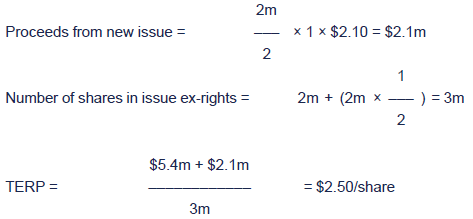
Note that the calculation can be done on the value of thewhole equity or on the basis of the minimum shareholding needed toacquire one extra share:



 Test your understanding 2 – TERP
Test your understanding 2 – TERP
MV of shares in issue = 10m × $2.70 = $27m

Note: that the calculation can be done on the value of thewhole equity or on the basis of the minimum shareholding needed toacquire one extra share:



 Test your understanding 3 – The value of a right
Test your understanding 3 – The value of a right



 Test your understanding 4 – The value of a right
Test your understanding 4 – The value of a right
$2.50 – $2.00 = 50c per new share issued


 Test your understanding 5 – Shareholders' options
Test your understanding 5 – Shareholders' options
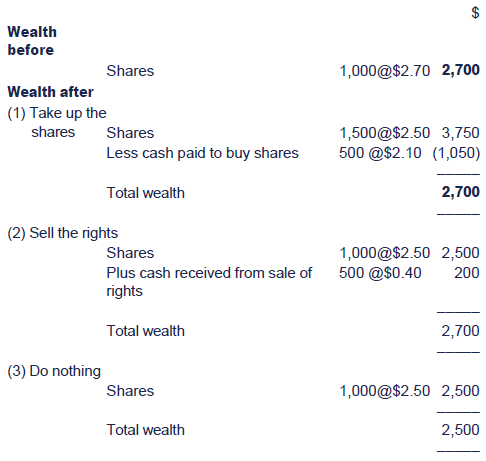
Therefore, total wealth under option 3 is $200 less than under options 1 and 2.
- By doing nothing you theoretically eventually forego the right to the new shares.
Note: the wealth of the investor who takes up the rightsappears to be unchanged at $2,700. In practice the funds raised would beused to invest in projects with positive NPVs so the wealth of theshareholder is likely to increase.

|
Created at 5/24/2012 4:17 PM by System Account
(GMT) Greenwich Mean Time : Dublin, Edinburgh, Lisbon, London
|
Last modified at 5/25/2012 12:54 PM by System Account
(GMT) Greenwich Mean Time : Dublin, Edinburgh, Lisbon, London
|
|
|
|
 |
Rating
:
|
 Ratings & Comments
(Click the stars to rate the page) Ratings & Comments
(Click the stars to rate the page)
|
 |
Tags:
|
|